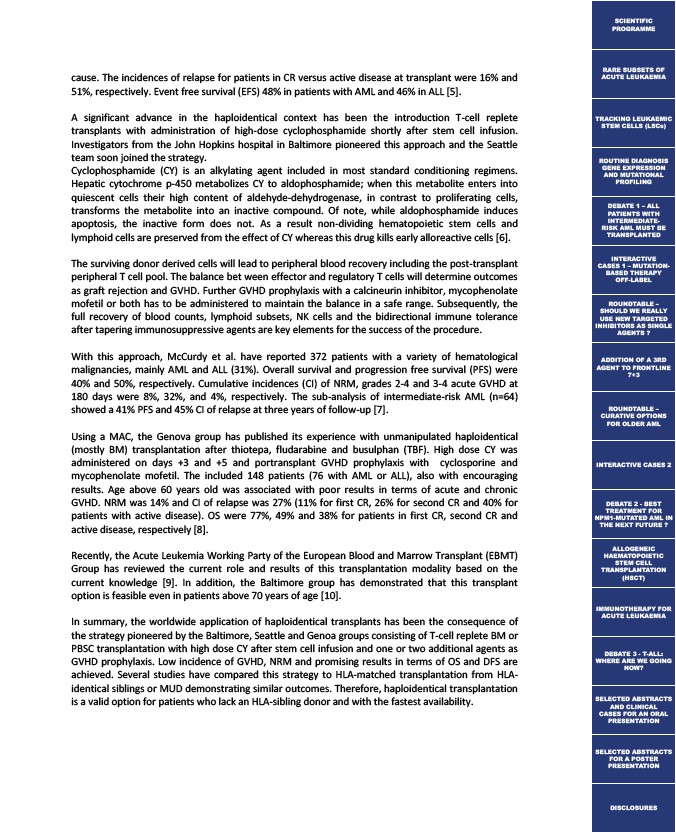
cause. The incidences of relapse for patients in CR versus active disease at transplant were 16% and
51%, respectively. Event free survival (EFS) 48% in patients with AML and 46% in ALL 5.
A significant advance in the haploidentical context has been the introduction T-cell replete
transplants with administration of high-dose cyclophosphamide shortly after stem cell infusion.
Investigators from the John Hopkins hospital in Baltimore pioneered this approach and the Seattle
team soon joined the strategy.
Cyclophosphamide (CY) is an alkylating agent included in most standard conditioning regimens.
Hepatic cytochrome p-450 metabolizes CY to aldophosphamide; when this metabolite enters into
quiescent cells their high content of aldehyde-dehydrogenase, in contrast to proliferating cells,
transforms the metabolite into an inactive compound. Of note, while aldophosphamide induces
apoptosis, the inactive form does not. As a result non-dividing hematopoietic stem cells and
lymphoid cells are preserved from the effect of CY whereas this drug kills early alloreactive cells 6.
The surviving donor derived cells will lead to peripheral blood recovery including the post-transplant
peripheral T cell pool. The balance bet ween effector and regulatory T cells will determine outcomes
as graft rejection and GVHD. Further GVHD prophylaxis with a calcineurin inhibitor, mycophenolate
mofetil or both has to be administered to maintain the balance in a safe range. Subsequently, the
full recovery of blood counts, lymphoid subsets, NK cells and the bidirectional immune tolerance
after tapering immunosuppressive agents are key elements for the success of the procedure.
With this approach, McCurdy et al. have reported 372 patients with a variety of hematological
malignancies, mainly AML and ALL (31%). Overall survival and progression free survival (PFS) were
40% and 50%, respectively. Cumulative incidences (CI) of NRM, grades 2-4 and 3-4 acute GVHD at
180 days were 8%, 32%, and 4%, respectively. The sub-analysis of intermediate-risk AML (n=64)
showed a 41% PFS and 45% CI of relapse at three years of follow-up 7.
Using a MAC, the Genova group has published its experience with unmanipulated haploidentical
(mostly BM) transplantation after thiotepa, fludarabine and busulphan (TBF). High dose CY was
administered on days +3 and +5 and portransplant GVHD prophylaxis with cyclosporine and
mycophenolate mofetil. The included 148 patients (76 with AML or ALL), also with encouraging
results. Age above 60 years old was associated with poor results in terms of acute and chronic
GVHD. NRM was 14% and CI of relapse was 27% (11% for first CR, 26% for second CR and 40% for
patients with active disease). OS were 77%, 49% and 38% for patients in first CR, second CR and
active disease, respectively 8.
Recently, the Acute Leukemia Working Party of the European Blood and Marrow Transplant (EBMT)
Group has reviewed the current role and results of this transplantation modality based on the
current knowledge 9. In addition, the Baltimore group has demonstrated that this transplant
option is feasible even in patients above 70 years of age 10.
In summary, the worldwide application of haploidentical transplants has been the consequence of
the strategy pioneered by the Baltimore, Seattle and Genoa groups consisting of T-cell replete BM or
PBSC transplantation with high dose CY after stem cell infusion and one or two additional agents as
GVHD prophylaxis. Low incidence of GVHD, NRM and promising results in terms of OS and DFS are
achieved. Several studies have compared this strategy to HLA-matched transplantation from HLA-identical
siblings or MUD demonstrating similar outcomes. Therefore, haploidentical transplantation
is a valid option for patients who lack an HLA-sibling donor and with the fastest availability.
SCIENTIFIC
PROGRAMME
RARE SUBSETS OF
ACUTE LEUKAEMIA
TRACKING LEUKAEMIC
STEM CELLS (LSCs)
ROUTINE DIAGNOSIS
GENE EXPRESSION
AND MUTATIONAL
PROFILING
DEBATE 1 – ALL
PATIENTS WITH
INTERMEDIATE-RISK
AML MUST BE
TRANSPLANTED
INTERACTIVE
CASES 1 – MUTATION-BASED
THERAPY
OFF-LABEL
ROUNDTABLE –
SHOULD WE REALLY
USE NEW TARGETED
INHIBITORS AS SINGLE
AGENTS ?
ADDITION OF A 3RD
AGENT TO FRONTLINE
7+3
ROUNDTABLE –
CURATIVE OPTIONS
FOR OLDER AML
INTERACTIVE CASES 2
DEBATE 2 - BEST
TREATMENT FOR
NPM1-MUTATED AML IN
THE NEXT FUTURE ?
ALLOGENEIC
HAEMATOPOIETIC
STEM CELL
TRANSPLANTATION
(HSCT)
IMMUNOTHERAPY FOR
ACUTE LEUKAEMIA
DEBATE 3 - T-ALL:
WHERE ARE WE GOING
NOW?
SELECTED ABSTRACTS
AND CLINICAL
CASES FOR AN ORAL
PRESENTATION
SELECTED ABSTRACTS
FOR A POSTER
PRESENTATION
DISCLOSURES